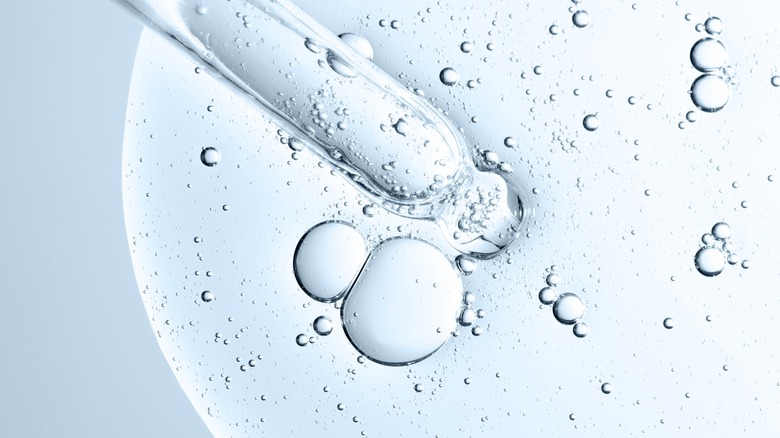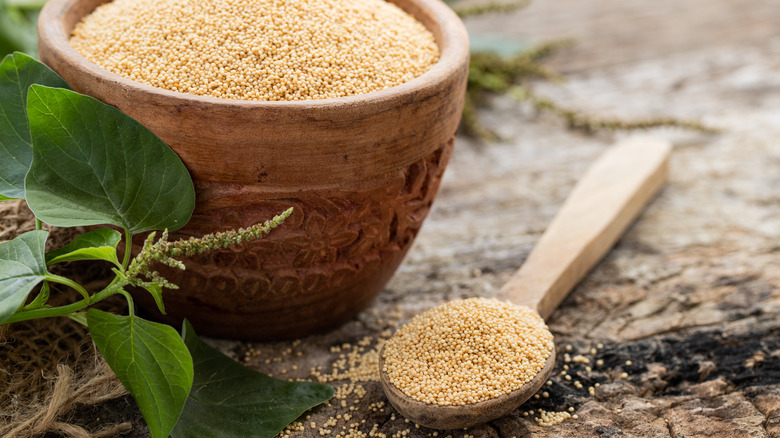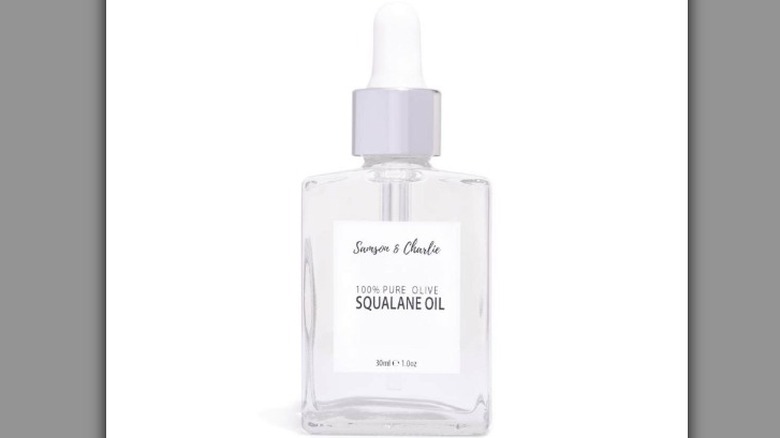Squalene Vs. Squalane: What's The Difference Between The Skincare Ingredients?
As health and wellness become more of a focus in the beauty sphere, skincare is rapidly rising in popularity in conjunction with more subtle makeup looks. Instead of having to layer on makeup to bring back a healthy glow to your skin, there's a new push to heal these issues from the inside out. Face washes, serums, and creams have always been popular products on the market, but nowadays, customers are empowering themselves with information about specific ingredients and what works best for their individual needs instead of blindly relying on "anti-aging" or "acne-fighting" labels on the bottle.
This, however, doesn't mean that it's easy. Wading through hundreds of multi-syllabic, scientific-sounding ingredients can get overwhelming, especially when some of these titles have only one letter to differentiate themselves. The information that was once reserved for chemists and product developers has made its way into our everyday vernacular, but that doesn't mean that there's not a learning curve. That's why we're tackling one of the most commonly confused products — squalane, or is it squalene? — and giving you a full rundown on what it actually does for your skin.
What is squalene?
If you're a fan of products that bring a youthful, hydrated glow to your complexion, you've likely used something that contains a derivative of squalene. According to WebMD, squalene, with an e, is a colorless oil that's naturally found in our skin and other living organisms. Because it's already produced by our sebaceous glands, our body easily absorbs this ingredient instead of leaving it to sit on the surface.
Including something that our body already produces as an ingredient in a skincare product might seem like overkill, but as you age, your body's production of squalene drops significantly. Because of this, derivatives of this ingredient are frequently included for its anti-aging properties, along with the obvious moisturizing benefits. This ingredient, however, has one major problem — it's not shelf stable. Squalene oxidizes when exposed to air, so by the time it's bottled up and used in your daily routine, all of the benefits would have already faded away.
What is squalane?
Because squalene oxidizes, scientists have worked out a way to stabilize this product through hydrogenation. If you think back to your high school chemistry classes, you might remember that hydrogenation is a chemical process that saturates an organic compound with hydrogen molecules (via ThoughtCo). This is frequently used to solidify oils — think margarine — but in this case, it allows us to reap the benefits of squalene that we haven't produced ourselves.
After it's been hydrogenated, squalene undergoes a bit of a name change into squalane, which is what you'll likely find in the ingredients list of your skincare products. This difference is really the only thing that separates the two substances, so you might hear their names used interchangeably to refer to the same ingredient. They both moisturize your skin and repair your skin barrier, but squalane has been synthesized so you can use it externally without losing its benefits.
How are these products produced?
Squalene is a naturally produced substance, and surprisingly, one of the most plentiful sources is actually shark liver. According to Lush, because sharks frequently live at lower depths of the ocean, their livers contain high amounts of fatty acid to survive. Their livers also make up a large portion of their body weight, so it's common to hunt sharks to harvest squalene because there's a large payoff per fish caught.
Unfortunately, this controversial practice means that many products that contain squalane aren't vegan or cruelty free. There are other options to harvest and synthesize squalene, but hunting sharks is one of the cheapest methods, so they're still commonly used despite the negative impacts on the environment and our oceans. Sharks are frequently vilified in pop culture, but their diet of plant-loving fish helps to protect ocean flora from going extinct and their role as scavengers helps to prevent the spread of diseases that sick or dead fish might have passed on.
What ethical alternatives are there?
If you're looking for a vegan or more environmentally-conscious alternative to shark-harvested squalene, there are several options on the market. Olives, sugarcane, amaranth, and wheat bran are common sources, and, while it usually takes more raw material to produce the same amount of product, plant-based options made from renewable, plentiful resources have less of a negative environmental impact.
Luckily, a large number of brands have gone with the plant-based approach after public calls for change, choosing to veer away from the more historic harvesting method. According to Shark Allies, two massive beauty and cosmetic corporations, Unilever and L'Oréal, made the switch back in 2008, while newer brands like e.l.f and The Ordinary used plant derivatives from the start. A few brands, however, are still lagging behind, like Cetaphil, Milani, Tarte, and Aveeno. Labels don't frequently differentiate between harvesting methods, but there are a few things you can look out for if you want to avoid shark-based products.
How to know if your products contain these ingredients
Obviously, the easy way to tell if your squalane is plant-derived is by listening to the brand. Many companies are pushing for transparency in their products, so they'll be the first to tell you where their ingredients are from. You can also trust products that have been officially certified as vegan or cruelty-free and have a Certificate of Analysis that confirms that their production methods align with consumer expectations.
If a company isn't as forthcoming with its information, however, it can be a bit more difficult to work out. If a product states that it contains squalane on the label and doesn't explicitly state that it's vegan, head over to the website — some brands will have further information available. If there's no clarification, this can be a bit of a red flag. You can try to reach out to a customer service representative to get a more precise answer, but few brands will publicly share that they source from shark liver.
When should you use these products?
Once you've found a product that you feel comfortable using that contains squalane, the application method is simple. This ingredient doesn't come with a wealth of rules like many exfoliating and anti-aging products do, so it's simple to incorporate into your skincare routine if you want to boost your skin's moisture. It usually comes in the form of a clear oil that you apply like any other serum or facial oil. Add a few drops to your skin, then gently massage your face, topping with your favorite moisturizer.
Squalane is an especially beneficial product if you have dry, sensitive skin. Because it's the same oil that your sebaceous glands produce naturally, it's unlikely that your skin will face any irritation or flare-ups from this product. Of course, you should always test products to ensure you won't have any negative reactions, but, as long as you stay away from irritating additives like fragrance, it's a very safe and gentle ingredient.
Which skincare ingredient is better?
Despite their frequent interchangeable use, squalene and squalane are two different things. Squalene is naturally produced and is great while it's doing its work in your body, but it's unlikely that you'll see it on the ingredients list of your skincare products due to its ability to oxidize when exposed to air. Because of this, look out for squalane, the hydrogenated byproduct, on the ingredients list if you want a gentle, non-greasy moisturizing product.
Squalane can be used on its own as a moisture-boosting oil, like in this 100% Plant-Derived Squalane from The Ordinary, but it's also frequently featured alongside ingredients like hyaluronic acid and peptides in face lotions, cleansers, and serums. After learning about this ingredient, you'll likely notice its inclusion in a number of your favorite hydrating products as a gentle but effective moisturizing agent. Scientific-sounding skincare names can be a bit intimidating, but with a bit of research, you'll be able to demystify their actual meanings and empower yourself to choose products that work for your skincare goals.






